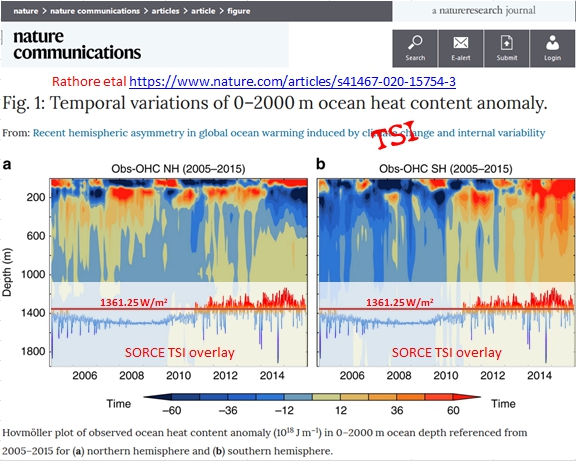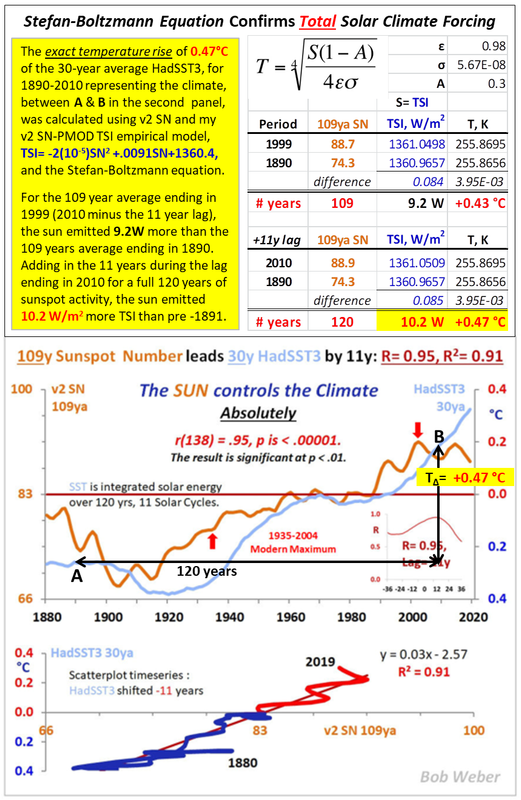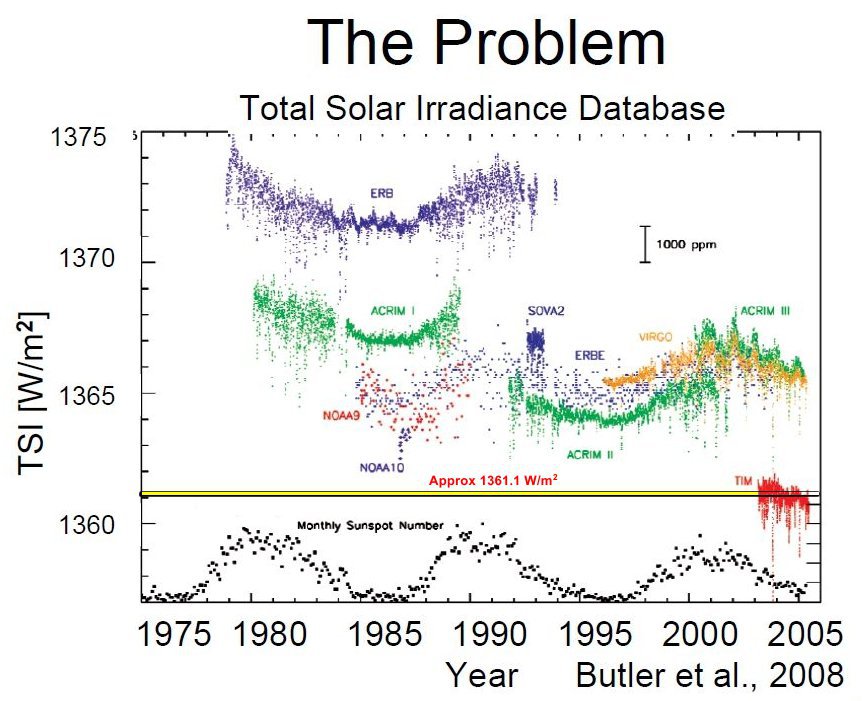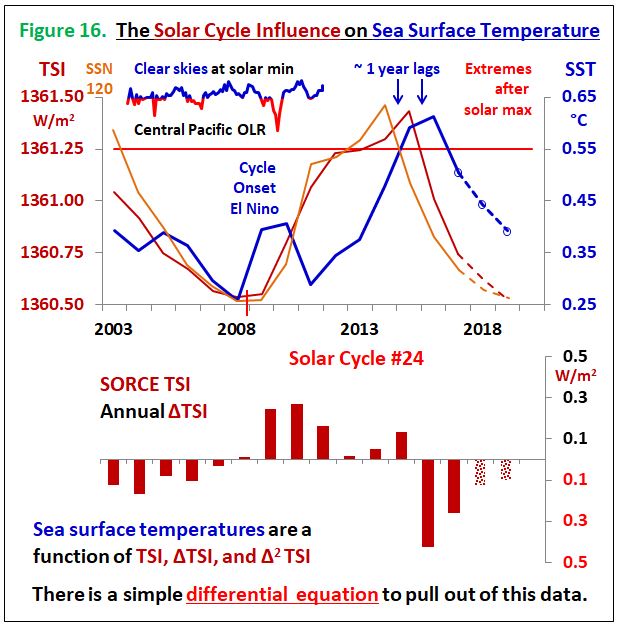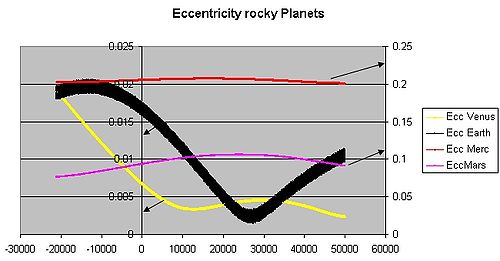Richard Willoughby
Introduction
This article is based on analysis of trends in solar radiation with time and location over the globe. Particular emphasis is placed on Net radiation absorption and release, which involves internal heat transfer as well as where heat is being retained and lost. The thermal responses of different regions are analysed as a means to understand why spatial and temporal changes in ToA solar EMR drive temperature trends.
Solar Electro-Magnetic Radiation (EMR)
The vast majority of energy in Earth’s climate system has been and is being sourced from the sun. The Solar Radiation and Climate Experiment (SORCE) Project was established to accurately measure the output of the sun using satellite based sensors. Chart 1 exhibits the principal results of the project that operated for 16 years producing daily determinations for solar EMR.

Top of the Atmosphere (ToA) solar EMR has a distinctive annual cycle with slight changes from year-to-year. The lowest recorded was 1315.872W/m^2 on July 4 2005 while the highest was 1408.573W/m^2 on January 9 2015 or an annual range up to 92W/m^2. The average over the recording period was 1361.1W/m^2. The monthly anomaly over the project period has a range of less than 2W/m^2. The orbital changes from year-to-year contribute a significant portion of the monthly anomaly. The remainder of the anomaly is due to the variation in the solar “constant”, which was determined to range from a low of 1357.019W/m^2 on October 3 2003 to 1362.278W/m^2 on February 7 2015 at constant distance of one astronomical unit. Most of the change in the solar constant is short duration spikes and troughs.
The SORCE Project confirmed the consistency of the so-called solar “constant” and the relatively large annual variation in ToA solar intensity due to Earth’s annual orbit of the sun. The variation in the solar constant contributes approximately 1W/m^2 to the monthly solar anomaly in an annual range of 92W/m^2. Hence the variation in solar constant is of the order of 1.1% of the annual variation in ToA solar intensity due to the orbital variation.
Earth’s ever changing orbit around the sun and daily rotation means there will never be any place on Earth that experiences identical orientation to the sun as it has in the past. That means the energy input to the climate system is always changing. Hence climate has always changed and always will.
It is possible to calculate the ToA solar intensity anywhere over the globe using orbital ephemerides, planetary geometry and a selected value for the solar constant, which is not quite constant but changes less than 0.2% whereas the annual variation in ToA intensity is almost 7% range of the average. Chart 2 is based on a solar constant of 1362W/m^2 for the 2022 orbit.

December is still the month of highest average solar intensity while June is the month of lowest. The ToA solar range is greatest at the poles with South Pole currently experiencing a range of 551W/m^2, which is somewhat greater than the 517W/m^2 at the North Pole. Over the course of the next 9,000 years, this will reverse. The equator receives the highest annual average solar EMR of 407W/m^2 but the lowest annual range. The South Pole has a current annual average of 180W/m^2 while the North Pole annual average is 166W/m^2: the lowest average for any location.
Net Radiation Energy
Not all of the solar EMR available at the top of the atmosphere is thermalised within the climate system. Some surfaces such as the polar snow covered land ice and sea ice as well as high level clouds are highly reflective. These surfaces reflect some of the available ToA solar EMR so it is not thermalised thereby giving rise to short-wave reflected radiation (SWR). Most of the solar EMR that is thermalised within the climate system is emitted back to space as long wave radiation commonly referred to as outgoing long-wave radiation (OLR). The Net radiation is determined by subtracting the OLR and SWR from the available solar EMR.
The Cloud and Earth’s Radiant Energy System (CERES) project has been producing high resolution global ToA radiation data since 2001 using satellite based instruments. The monthly average Net radiation ranges from typically minus 208W/m^2 up to 190W/m^2. Image 1 provides a spatial perspective of the annual range for Net radiation in W/m^2 between the maximum and minimum for both hemispheres.

Net radiation is well correlated with the solar EMR across the regions but the dependence changes with the type of surface. For example, regions with permanent ice cover such as Antarctica and Greenland have considerably lower range in Net radiation when compared with adjacent land or ocean. The variation in Net radiation at the equator is very low indicative of the near constant solar EMR over the equator..
Ocean Heat Content
The Argo project has been producing relatively high resolution and consistent ocean temperature data from the surface to a depth of 2000m since 2005. Image 2 depicts how the average temperature in Centigrade degrees of the top 2000m of the global oceans has changed from the start of the Argo project in 2005 to the end of 2023.

The range in temperature is quite wide from minus 5.3C up to 6.2C with an average of 0.0897C. The average temperature increase corresponds to additional heat of 243ZJ (ZettaJoules, 1E21) over the 19 year period or average annual increase of 12.9ZJ. To put that in perspective, it corresponds 0.2% of the 5415ZJ of the ToA solar EMR available annually.
The change in ocean heat content (OHC) as displayed spatially in Image 2 does not have any particularly notable features. Looking closely, it is apparent that the Gulf of Mexico and the Mediterranean Sea have retained more heat. There are hot spots in the region of the Ferrel Cells in both hemispheres with the band of interspersed warmer and cooler regions across the Southern Hemisphere (SH) being more evident than across the Northern Hemisphere (NH).
It is worth noting that the Argo OHC data between 2005 and 2015 was used as a basis to calibrate the CERES radiation data because the radiation instruments and associated analysis lack the inherent accuracy to measure, in absolute terms, the small changes occurring in the global ToA radiation budget. The retained heat in the oceans corresponds to a Net absorption of 0.8W/m^2.
Chart 3 compares the accumulated Net radiation and OHC by latitude for oceans in the Northern Hemisphere and Southern Hemisphere for the concurrent interval with the Argo measurements from December 2005 to December 2023.

The Net radiation peaks at 160ZJ/degree at the Equator; drops to zero at 37N and 37S then reaches minimums at 55S of minus 2ZJ/degree and at 72N at minus 1.2ZJ/degree.
The OHC has a peak at the Equator and distinct peaks in the region of the Ferrel Cells in both hemispheres. Peak heat retention of 5ZJ/degree occurs at 45S and 3.8ZJ/degree at 37N. These peaks in retained heat were not so obvious in Image 2 because the warmer zones are interspersed with cooler zones. The Ferrel Cells are net condensing regions where increasing precipitation steepens the thermocline thereby retaining more heat in the deep ocean. It is ocean heat retention in regions of increased precipitation rather than surface heat uptake across the entire ocean surface.
Chart 4 provides a temporal perspective on cumulative heat for the overlapping period of Argo and CERES data.

Over the 19 years of concurrent data, the oceans of the NH and the atmosphere above have absorbed 1337ZJ and retained 106ZJ or 7.9% of the absorbed radiation. The SH has absorbed 618ZJ and retained 146ZJ or 23.6%.
Land & Ocean Response to Solar EMR
Both land surfaces and ocean surface exhibit positive response to ToA solar EMR but there are noteworthy differences. Land responds faster and with greater range than the ocean. The NH land mass reaches its maximum temperature in July and minimum temperature in January. The SH land mass is the reverse. Image 3 displays the maximum to minimum range of temperature for the land surface over an annual cycle based on the Global Historic Climatology Network (GHCN) for global 2m air temperature over land (LST). Note that GHCN does not provide coverage for Antarctica.

It is apparent that most of the land surface experiences a range greater than 15C. The exception is the relatively small proportion in the tropics that has an annual range of less than 3C.
Ocean surfaces respond slower and over a smaller range than land; exhibiting widest range from February to August, thus lagging the peak range in solar EMR by two months. Image 4 displays the spatial temperature range for the oceans using Reynolds OI sea surface temperature (SST).

It is apparent that the ocean adjacent to the NH land mass undergo a much wider temperature range than any region of the oceans in the SH. Chart 5 presents the same data as the two Images 3 and 4 above but with temperature range plotted against latitude.

Land comprises 68% of the total surface area between 60N to 70N so the combined area averaged temperature response between those latitudes is dominated by the land response. Antarctica aside, most land in the SH is in the lower latitudes but is only a small proportion of the total surface area. Accordingly the temperature response of the SH is dominated by the response of the oceans, which has a narrower range than the land.
Temperature Trends Satellite Era
The satellite era improved the global coverage of surface temperature measurement particularly for the oceans. The Reynolds (SST) combines satellite measurements over the oceans with surface measurements to produce accurate, high spatial resolution data. Image 5 depicts the change in SST from August 1982 to August 2022. Global SST has exhibited the largest monthly increase in August so Image 5 shows where the oceans are warming the most.

The average SST has increased by 0.474C over the period but some regions are up to 3.8C cooler with some areas along the coastline of the Arctic Ocean up to 13.1C warmer.
Global land has experienced the greatest monthly increase in January. Image 6 displays how the LST has changed from January 1982 to January 2022 based on the GHCN LST data, which excludes Antarctica.

The average increase is 1.8C with some regions cooler by 6.4C and some warmer by 17.4C. The average increase in LST is 3.8 times the average increase in SST.
Chart 6 examines the monthly temperature anomaly trends relative to latitude for surface measurements based on the Berkeley LST; the lower troposphere using UAH TLT and the Argo deep ocean temperature.

The three different sets have significantly different rates of change but there are similarities in the profiles. All three data sets exhibit an increasing trend relative to latitude with the high northern latitudes having the greatest increase and high southern latitudes reaching negative trends south of 60S. All three data sets exhibit distinctive humps in the region of the Ferrel Cells in both hemispheres. The equatorial zone shows little to no increase.
Heat Transfer Ocean to Land
Oceans and their atmospheres are net absorbers of radiant heat on average while land and its atmosphere release heat back to space on average. From 2001 to 2023, the total heat absorbed by the oceans was 2432ZJ while the land released 1903ZJ. The heat transfer is primarily associated with transfer of atmospheric water from the oceans to land. Solar EMR thermalised in the ocean and atmosphere above result in water evaporation from the ocean surface and then transported by air currents to the land where radiative cooling causes the water vapour to condense then precipitate as rain, snow or hail.
The water transfer from ocean to land can be assessed by monitoring the runoff of water from land being returned to the ocean. The Global Runoff Data Centre (GRDC) has been compiling runoff data for over a century and has global coverage at very high resolution. Image 7 provides a snapshot of the data for May 2019. May is the month of highest runoff typically averaging 1mm/day for the entire land mass totalling 1.47E14m^2 where runoff occurs. The data does not include glacier calving or ice shelf loss.

The May runoff is relatively high in the mid to high northern latitudes following the annual melt. There is also high runoff from land on and near the Equator, which is less seasonal. For the 20 years to December 2019, the annual runoff averaged 292mm; equivalent to 43Gt of water per year.
Chart 7 plots the Net heat absorbed for land and ocean as well as the calculated heat release from atmospheric water condensing to produce runoff; all for 2019.

Both ocean and land absorb heat in the tropics and both release heat at higher latitudes. The ocean and its atmosphere have peak absorption of 8.5ZJ/degree at the Equator. Land and its atmosphere absorb almost 2ZJ/degree at the Equator. The heat release through water vapour solidifying peaks at 3.5ZJ/degree also at the Equator. The heat release to produce the runoff is based on the heat of solidification for water. Using that value results in heat loss associated with runoff of 119ZJ. Some of the accumulation feeding the 2019 runoff would have occurred in 2018, so is not directly associated with the 108ZJ net absorption of the oceans and 81.8ZJ net release from land. Most land along the Equator sustains enough moisture to establish powerful convective cells that are mid-level convergent zones but high level divergent zones that are net radiation absorbers due to atmospheric absorption and then sensible heat advection. The tropical land and atmosphere above from 20S to 20N absorbed 50.5ZJ Net radiation in 2019.
Changing Regional Solar EMR
Earth’s rotation and orbit of the sun are obvious drivers of daily and seasonal weather changes. The ever changing orbit is also responsible for longer term trends observed as climate change. The sun is a relatively stable source of radiation energy reaching the top of Earth’s atmosphere as outlined in the opening section.
Chart 8 shows how ToA solar EMR over NH land has changed for the months of highest and lowest solar EMR relative to the corresponding monthly average from 1502 to 1533. The accumulation of the anomaly for the two months is also displayed on the right-hand axis. The asymmetry of the changes for the high and low month is a result of the distribution of land over the globe resulting in the average of the monthly accumulations being positive and totalling 20ZJ from 1500 to 2100.

The reference period for the anomaly was chosen because it coincided with the NH having experienced the lowest solar intensity in the current 23,000 year precession cycle. In July 2022, Earth was some 40,000km closer to the sun than in 1509. The orbit was at aphelion on July 4 in 2022 compared with June 17 in 1509. In other words, compared with 1509, Earth was closer to the sun at its maximum distance from the sun in 2022 but 17 days later in the year due to a combination of orbital eccentricity and precession. There are other less significant variables in the ephemerides such as obliquity of the axis which will change from 23.50327 degrees in 1501 to 23.4266 degrees in 2100. The moon orbit of Earth also causes nutation of Earth’s axis over an 18 year cycle that can be observed in good temperature records but it is a very small change compared with the three larger changes in orbit.
The accumulation of energy over land is not simply a notional change. There are observable consequences. For example, 16ZJ from 1501 to present time going into melting land ice would result in a sea level rise of 120mm over 500 years or a change of 8ZJ in the past 100 years adding 0.6mm/year to sea level. The resulting reduction of permanent ice reduces the albedo of the land so the land warms due to both loss of ice and increased solar absorption. Alternatively 16ZJ could add 64Gt of biomass. The presence of biomass will moderate temperature extremes by retaining surface moisture. Observations over the past 500 years indicate that both permanent land ice has reduced and biomass has increased. So these changes are, indeed, cumulative.
From a spatial perspective, the range in solar EMR over land is increasing in the NH but reducing in the SH. Chart 9 displays the anomaly for highest and lowest month as well as the average over all land surface by latitude.

The observed latitudinal temperature trends shown in Chart 6 above are similar to the trend in solar EMR of Chart 9 but it is notable that land south of the Equator has been experiencing reducing sunlight range but still warming. The reason becomes apparent once atmospheric water is considered per Image 8 using RSS total precipitable water (TPW) data.

The mean increase of 0.4mm/decade is significant because the average level in 1988 was 27mm. So over the 35 years of the record, the average has increased by 5%. The increase is more significant in the NH and there is already large regions in the SH with no trend or negative trend.
The increasing average solar intensity over the NH land will continue to drive the upward trend in TPW in the NH. The area of NH ocean reaching the regulating limit of 30C is increasing at 2.5%/decade. Ocean warm pools now cover 10% of the NH oceans in September and, on present trend, will reach 50% by 2200. Chart 10 shows how SWR and OLR have changed across the latitudes from 2001 to 2023.

SWR has reduced at all latitudes, on average by 2.4W/m^2, apart from the region of the South Pole and from the Equator to 7N. OLR has increased, on average by 1.3W/m^2, at all latitudes apart from the two regions where SWR reduced. The region just north of the equator is the same location where TPW is rising the most and where more ocean surface is reaching the 30C regulating limit. The increase in brightness and reduction in OLR are associated with the convective instability that sets the sustainable temperature limit to 30C. Once the atmosphere is in cyclic equilibrium with the surface at 30C the increase in SWR is twice the reduction in OLR so a very powerful negative feedback. The inverse relationship is evident in Chart 10 but the magnitude is not evident because no region sustains the 30C limit over an annual cycle.
The Energy Intensity of Forming Snow
Snow falling on land is an energy intensive process. The energy requirement is far greater than just the latent heat of water vaporisation. Table 1 provides the energy inherent in two atmospheric columns at conditions related to ocean warm pools and conditions conducive to forming snow over land.

Water liberated from the ocean surface requires latent heat to vaporise but also requires sensible heat to expand the atmospheric column as the lower density water gas elevates the column. For a 30C warm pool, the average enthalpy change in the column associated with increasing precipitable water is 6.26E6J/m^2/mm. Note here that the enthalpy associated with the water vapour at the cooler conditions is almost twice that of the warm pool. So evaporation at the higher temperature has lower sensible heat associated with it. From a process perspective, the least energy cost to get water into the atmosphere is at the highest possible temperature, which is 30C.
Air diverging at altitude from a warm pool and moving over land will lose moisture as it cools. The water that ends up on land could precipitate and evaporate many times before it eventually reaches land that is below freezing. The warm pool has TPW of 89.6mm for the typical conditions that has to be reduced to 6.7mm before the air reaches freezing land. Each mm of water equivalent snow has an energy cost in the range 1.14E7 to 8.37E7J/m^2. Accordingly, it would take from 4.2ZJ up to 31ZJ to lower the oceans by 1mm to produce 4mm of permanent ice on land north of 40N. At the higher value, there would need to be considerable runoff associated with the initial water transfer from the ocean. However, it is noted that runoff is trending down but precipitation over land is trending up. Advection of water from ocean to land is reducing as the land warms up but the water cycle over land is speeding up due to increased atmospheric moisture.
Temporal Trends & Thermal Inertia
Historical records reveal that climate change is not something that started last century. The central England temperature (CET) record is the longest continuous instrumented temperature record available. Chart 11 provides the anomalous record relative to the first 33 years of the record with three 100 year trends and the last 70 years. Each 100 year interval has a positive trend, albeit the second 100 years just positive, with last 70 years higher than any of the 100 year trends; indicating acceleration similar to the average of the highest and lowest accumulated solar EMR over land in Chart 8 above..

Earth’s climate system has thermal inertia. Measured and visible changes lag the changing solar EMR. Surface temperature over land has a phase shift of 4 weeks relative to the ToA solar EMR. The NH oceans lag by 8 weeks and the SH oceans lag by 10 weeks. Once the phase shifts are made, the thermal responses of the respective surfaces are highly correlated to the available ToA solar EMR over the particular surface as shown in Chart 12 for period 1982 to 2022.

The different slopes of the correlation curves indicate the relative response to solar EMR for the different surface. The thermal response of global land is 8.7 times the response of the SH oceans.
Ocean surface circulations have periods of decades. The meridional overturning of oceans is in the range of 300 to 400 years and the abyssal ventilation can take up to 2,000 years. However these changes are relatively short compared with ice perched on land. The Greenland ice sheet has ice as old as 400,000 years while the Antarctic ice cores have been dated as far back as 2.7Ma.
Greenland has retained most of its ice during the Holocene and it is now advancing again as displayed in Chart 13 based on Rutgers Snow Lab measurements. The trend is toward 100% permanent cover before 2100.

The altitude of Greenland’s summit has recorded a decadal increase of 170mm.
Conclusion
The key points from the above analysis are:
- Peak solar intensity has been increasing in the Northern Hemisphere for 500 years.
- The mid to high latitudes in the NH are dominated by land, which has a much higher response to solar intensity than oceans.
- The minimum monthly solar intensity in the NH is declining but is low to zero in high latitudes so the decline is much smaller than the increase in the peak meaning the average is increasing. The minimum from 67N is always zero so cannot decline.
- The increase in average solar intensity has cumulative and compounding effects such as land ice melting reducing albedo and increase in woody biomass that increases thermal inertia.
- The high temperature in the NH has a corresponding increase in TPW, particularly in September, giving rise to increasing snowfall.
Additional points below are:
- Permafrost is continuing to retreat apart from Greenland where there is now an established upward trend in permanent cover.
- Glaciation is an energy intensive process. The cooling comes after the ice becomes permanent.
Milankovitch was fundamentally correct about the cause of climate trends in his analysis of Earth’s orbit early last century but the data was not readily available to appreciate the details of key processes. The process of glaciation in the NH is dominated by the precession cycle and the distribution of land over the globe. Also glaciation is an energy intensive process. For example, the Antarctic ice sheet would take 185,000 years to build from nothing to present level if the current annual ocean heat retention went entirely into evaporating water to produce snow over Antarctica. Further, summer solstice solar intensity over the South Pole peaked at 566W/m^2 2,600 years ago but was not sufficient to melt the ice. Once ice sheets form, they are difficult to melt due to the combination of albedo of the fresh snow; the low angle of incident sunlight at high latitudes and atmospheric temperature lapse rate maintaining frigid air over them.
The current increasing trend in NH peak solar intensity commenced around 500 years ago. The Viking colonisation of Greenland failed around the time of lowest summer solstice sunshine in the NH. Since the lowest peak intensity, the temperature of the NH has been trending upward with some cumulative thermal response being observed such as permanent ice loss and increased biomass as well as a corresponding increase in atmospheric water. There is now a clear upward trend in early season snowfall per Chart 14 and a lesser upward trend in maximum extent normally set in December. The permanent snow cover extent over NH land is still declining with most permafrost measurements showing permafrost still melting.

The NH land and oceans will continue to have a warming trend until the permafrost advances southward again. Greenland provides the early indicator for advancing permanent ice due to its proximity to warming ocean water. Permafrost will advance southward from the Arctic Ocean coastline and down from elevated ground; initially on north facing slopes. The average temperature of the NH land will decline as the permanent ice advances but the oceans will remain warm. The increase in elevation of the ice covered ground and reducing level of the oceans will create a greater temperature differential between ocean and land surfaces due to the lapse rate. This will also accelerate snowfall and the ice advance.
The precession cycle has a typical period of 23,000 years. Recent glacial episodes in the NH terminated after three or four precession cycles when the land reaches its limit of ice carrying capacity with glacier calving slowing down the water cycle. During glaciation, each upswing in the NH peak solar intensity aligns with the sea level decline until the glacier calving slows down the water cycle. The calving accelerates as sea level rises once the peak solar intensity in the NH is increasing. Glacier calving becomes the switch that changes the rising sunlight from land ice accumulation to ice loss.
During the Holocene, the maximum surface temperature, based on proxies, was achieved not long after the NH summer solstice solar EMR peaked and sea level was close to present level. The last peak at 45N reached 526W/m^2 11,200 years ago. The minimum of 483W/m^2 occurred 500 years ago. The next peak of 505W/m^2 will be in 9,000 years. By then, based on sea level reconstructions, the sea level will be 20m to 40m lower than present.
In the last two decades the Net radiation absorbed by the NH oceans and atmosphere has shown a strong upward trend per Chart 15.

The proportion being retained in the NH oceans is only 7.9% since 2005 and is declining as a proportion. So the ocean heat input that drives the water cycle in the NH has a sustained upward trend. This means the NH water cycle over land and ocean is increasing; consistent with strong upward trend in TPW in the northern latitudes; reaching 0.8mm/decade between 3N and 15N. The global water runoff has declined over recent decades apart from the May runoff trending upward. The overall decline in runoff means there is lower heat advection from ocean to land. However precipitation has increased over most of the land in the NH consistent with increased water cycle over land.
The Author
Richard Willoughby is a retired electrical engineer having worked in the Australian mining and mineral processing industry for 30 years with roles in large scale operations, corporate R&D and mine development. A further ten years was spent in the global insurance industry as an engineering risk consultant where he developed an enduring interest in natural catastrophes and changing climate.

